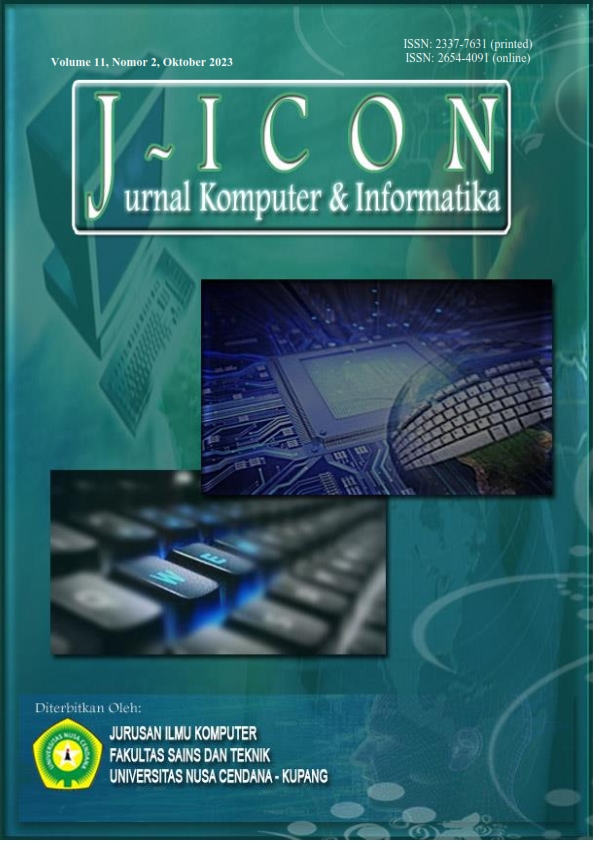CLASSTERIZATION OF TRACKING STUDY DATA ABOUT CAREER AND EMPLOYMENT OF HIGHER GRADUATES USING K-MEANS ALGORITHM
Abstract
Higher education has a responsibility to produce quality graduates. One indicator of the quality of graduates is the status of getting a job, the condition of the suitability of the field of work with the educational program pursued, and the waiting period to get the job. What is being done to find out these conditions is to conduct a tracer study for graduates. This study analyzes data from a college graduate tracking study about careers and jobs using a data mining clustering algorithm, namely K-Means. The results showed that the analysis of the tracking study data formed several graduate clusters with an evaluation value of the Davies-Bouldin Index (DBI) reaching 0.287 in the first trial and 0.291 in the second trial. The clusters formed consist of groups of graduates with status still needing to be working or currently working. The profile of graduates from each cluster can be identified in the form of a relatively short waiting period of less than six months to get a first job or a relatively slow waiting period of more than one year. Another cluster specification that is formed is about the profile of graduates with the level of compatibility between the education attained and the field of work carried out. The results of this study serve as feedback for study program managers to measure the quality of graduates and the improvements in the educational process that need to be made.
Downloads
References
Y. E. Fadrial, “Klasterisasi Hasil Evaluasi Akademik Menggunakan Metode K-Means (Studi Kasus Fakultas Ilmu Komputer UNILAK),” Semin. Nas. Teknol. Inf. Ilmu Komput., vol. 1, no. 1, pp. 53–65, 2020, doi: 10.31849/semaster.v1i1.5492.
V. Novita Sari, Y. Yupianti, and D. Maharani, “Penerapan Metode K-Means Clustering Dalam Menentukan Predikat Kelulusan Mahasiswa Untuk Menganalisa Kualitas Lulusan,” Jurteksi, vol. 4, no. 2, pp. 133–140, 2018, doi: 10.33330/jurteksi.v4i2.53.
D. Praseptian M, A. Fadlil, and H. Herman, “Penerapan Clustering K-Means untuk Pengelompokan Tingkat Kepuasan Pengguna Lulusan Perguruan Tinggi,” J. Media Inform. Budidarma, vol. 6, no. 3, p. 1693, 2022, doi: 10.30865/mib.v6i3.4191.
N. Nurahman, A. Purwanto, and S. Mulyanto, “Klasterisasi Sekolah Menggunakan Algoritma K-Means berdasarkan Fasilitas, Pendidik, dan Tenaga Pendidik,” MATRIK J. Manajemen, Tek. Inform. dan Rekayasa Komput., vol. 21, no. 2, pp. 337–350, 2022, doi: 10.30812/matrik.v21i2.1411.
H. Priyatman, F. Sajid, and D. Haldivany, “Klasterisasi Menggunakan Algoritma K-Means Clustering untuk Memprediksi Waktu Kelulusan Mahasiswa,” J. Edukasi dan Penelit. Inform., vol. 5, no. 1, p. 62, 2019, doi: 10.26418/jp.v5i1.29611.
R. Kurniawan, M. M. M. Mukarrobin, and M. Mahradianur, “Klasterisasi Tingkat Pendidikan Di Dki Jakarta Pada Tingkat Kecamatan Menggunakan Algoritma K-Means,” Technol. J. Ilm., vol. 12, no. 4, p. 234, 2021, doi: 10.31602/tji.v12i4.5633.
N. Mirantika, A. Tsamratul’Ain, and F. D. Agnia, “Penerapan Algoritma K-Means Clustering Untuk Pengelompokan Penyebaran Covid-19 di Provinsi Jawa Barat,” Nuansa Inform., vol. 15, no. 2, pp. 92–98, 2021, doi: 10.25134/nuansa.v15i2.4321.
A. K. Wardhani, “Implementasi Algoritma K-Means Untuk Pengelompokkan Penyakit Pasien Pada Puskesmas Kajen Pekalongan,” J. Transform., vol. 14, pp. 30–37, 2016.
M. Hariyanto and R. T. Shita, “Clustering Pada Data Mining Untuk Mengetahui Potensi Penyebaran Penyakit DBD Menggunakan Metode Algoritma K-Means dan Metode Perhitungan Jarak Euclidean Distance,” SKANIKA, vol. 1, no. 1, pp. 117–122, 2018, doi: 10.36080/skanika.v1312.1456.
A. F. Khairati, A. A. Adlina, G. F. Hertono, and B. D. Handari, “Kajian Indeks Validitas pada Algoritma K-Means Enhanced dan K-Means MMCA,” in Prosiding Seminar Nasional Matematika, vol. 2, pp. 161–170, 2019.
R. D. Ramadhani and D. J. AK, “Evaluasi K-Means dan K-Medoids pada Dataset Kecil,” Semin. Nas. Inform. dan Apl., vol. 3, pp. 20–24, 2019.
Copyright (c) 2023 Joko Sutrisno, Arief Wibowo, Bayu Satria Pratama

This work is licensed under a Creative Commons Attribution 4.0 International License.
The author submitting the manuscript must understand and agree that if accepted for publication, authors retain copyright and grant the journal right of first publication with the work simultaneously licensed under a Creative Commons Attribution (CC-BY) 4.0 License that allows others to share the work with an acknowledgment of the work’s authorship and initial publication in this journal.
 Joko Sutrisno(1)
Joko Sutrisno(1)




